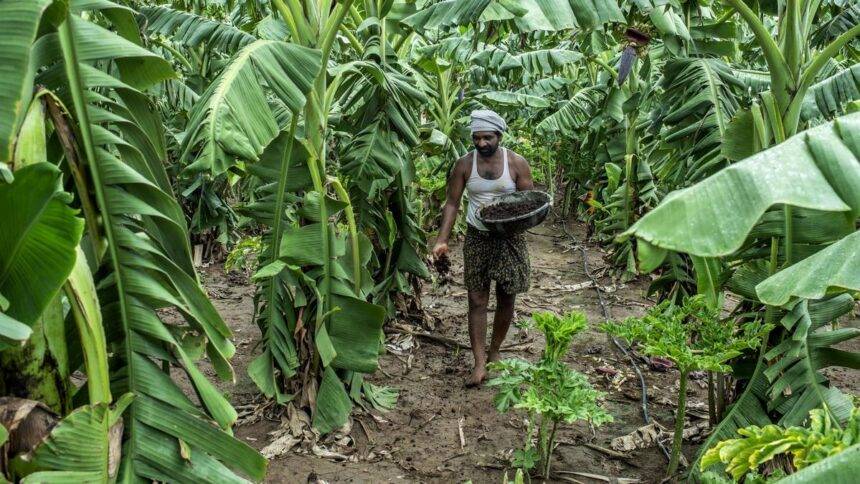Main Points In Hindi (मुख्य बातें – हिंदी में)
-
प्राकृतिक खेती की बढ़ती लोकप्रियता: भारत में जैव विविधता, मृदा स्वास्थ्य और कम रासायनिक आदानों पर ज़ोर देने वाली प्राकृतिक खेती की पद्धति, विशेष रूप से आंध्र प्रदेश, गुजरात और हिमाचल प्रदेश में तेजी से लोकप्रिय हो रही है। यह टिकाऊ कृषि पर ध्यान केंद्रित करने वाले मॉडल प्रदान कर रही है।
-
राज्य स्तरीय पहलों की सफलताएँ: हिमाचल प्रदेश की खुशहाल किसान योजना, गुजरात की ‘आपणु डांग प्राकृतिक डांग’ पहल, और आंध्र प्रदेश की समुदाय-प्रबंधित प्राकृतिक खेती (एपीसीएनएफ) जैसी पहलों ने किसानों को प्राकृतिक कृषि अपनाने में मदद की है, जिससे उनकी आय में वृद्धि और मिट्टी की उर्वरता में सुधार हुआ है।
-
केंद्रीय बजट का महत्व: 2024-25 का केंद्रीय बजट प्राकृतिक खेती के लिए महत्वपूर्ण संसाधन आवंटित करता है, जिसमें 10,000 जैव-इनपुट संसाधन केंद्र (बीआरसी) स्थापित करने की योजना शामिल है, जिसका लक्ष्य एक करोड़ किसानों को प्राकृतिक खेती में लाने की है।
-
चुनौतियाँ और जोखिम: प्राकृतिक खेती के लिए आवश्यक श्रम, जैव-इनपुट की अनुपलब्धता, और बाजार तक पहुँच की चुनौतियाँ प्रमुख बाधाएँ हैं। यदि सप्लाई चेन मजबूत नहीं होती, तो किसान रासायनिक आदानों की ओर लौट सकते हैं, जिससे प्राकृतिक खेती की पहल कमजोर हो सकती है।
- दीर्घकालिक सफलता की शर्तें: प्राकृतिक खेती को सफल बनाने के लिए इनपुट आपूर्ति श्रृंखलाओं को मजबूत करना, श्रम-गहन प्रक्रियाओं का मशीनीकरण, और बाजार पहुंच में सुधार आवश्यक है। यह महत्वपूर्ण है कि क्या भारत प्राकृतिक उत्पादों के लिए मजबूत बाजार स्थापित कर सकता है ताकि छोटे किसानों को आर्थिक रूप से लाभ हो।
Main Points In English(मुख्य बातें – अंग्रेज़ी में)
Here are the main points about natural farming and its implications for Indian agriculture:
-
Rising Popularity of Natural Farming: Natural farming, which emphasizes biodiversity, soil health, and reduced chemical inputs, is gaining traction in India. States like Andhra Pradesh, Gujarat, and Himachal Pradesh have become testbeds for this sustainable agricultural method, aiming to transform the agricultural landscape.
-
Successful Initiatives and Challenges: Various state initiatives highlight both successes and challenges. For instance, Himachal Pradesh’s "Prakritik Kheti Khushhal Kisan Yojana" provides financial assistance to farmers, while Gujarat’s "Apanu Dang Natural Dang" program offers subsidies for adopting natural farming practices. However, challenges such as supply chain inconsistencies for essential inputs and labor intensity hinder widespread adoption.
-
Ambitious Budget Allocations: The 2024-25 central budget has made significant allocations for natural farming, including the establishment of 10,000 Bio-Input Resource Centers (BRCs) to reduce dependence on chemical fertilizers. However, the implementation faces challenges like ensuring a reliable supply of inputs like cow dung and urine, crucial for producing organic fertilizers.
-
Labor and Market Access Issues: Natural farming requires more human intervention compared to chemical-based farming, which poses a barrier, especially for farmers lacking mechanization or resources. Furthermore, while natural products may fetch higher prices, many farmers struggle to access premium markets, limiting their economic benefits.
- Future Prospects and Challenges: Although natural farming has the potential to revolutionize Indian agriculture, its success depends on overcoming significant barriers such as strengthening supply chains for bio-inputs, improving labor efficiency through mechanization, and enhancing farmers’ access to markets. The potential realization of chemical-free agriculture remains uncertain and will require robust support and infrastructure development.


Complete News In Hindi(पूरी खबर – हिंदी में)
जैव विविधता, मृदा स्वास्थ्य और कम रासायनिक आदानों पर जोर देने वाली प्राकृतिक खेती, भारत के कृषि परिदृश्य में लोकप्रियता हासिल कर रही है। आंध्र प्रदेश, गुजरात और हिमाचल प्रदेश इस आशाजनक पद्धति के लिए परीक्षण स्थल के रूप में उभरे हैं, जो टिकाऊ कृषि पर ध्यान केंद्रित करने वाले अद्वितीय मॉडल प्रदर्शित करते हैं। 2024-25 का केंद्रीय बजट, प्राकृतिक खेती के लिए पर्याप्त संसाधनों के आवंटन के साथ, एक महत्वपूर्ण क्षण है। हालाँकि, जैसे-जैसे हम कम कार्बन वाले कृषि भविष्य की ओर बढ़ रहे हैं, अभी भी कुछ प्रासंगिक सवालों के जवाब दिए जाने बाकी हैं। क्या प्राकृतिक खेती भारतीय कृषि को बदल देगी? या यह एक महत्वाकांक्षी लेकिन विशिष्ट प्रयास बना रहेगा?
कुछ राज्यों में सफलताएँ और चुनौतियाँ
हिमाचल प्रदेश में, राज्य की प्राकृतिक खेती खुशहाल किसान योजना (पीके3वाई) बदलाव की एक महत्वपूर्ण चालक रही है। किसानों को स्वदेशी गाय खरीदने के लिए ₹33,000 मिलते हैं और गौशाला की स्थिति में सुधार करने के लिए अतिरिक्त ₹8,000 मिलते हैं, जिससे ‘जीवामृत’ और ‘बीजामृत’ के उपयोग को बढ़ावा देने में मदद मिलती है, जो गाय के गोबर और मूत्र से बने जैव उर्वरक हैं। ये प्रथाएं बिलासपुर जैसे जिलों में 6,438 किसानों को प्राकृतिक खेती अपनाने में मदद कर रही हैं। प्राकृतिक रूप से उगाये गये मक्के को 3000 रूपये प्रति क्विंटल के समर्थन मूल्य पर खरीदा जा रहा है।
गुजरात में, ‘आपणु डांग प्राकृतिक डांग’ पहल, जिसने 2021 में डांग जिले को पूरी तरह से प्राकृतिक खेती-आधारित घोषित किया, मशीनीकरण और वित्तीय सहायता पर राज्य के फोकस का उदाहरण है। किसानों को एक देशी गाय के पालन-पोषण के लिए प्रति माह ₹900 मिलते हैं और ‘जीवामृत’ तैयार करने के लिए प्राकृतिक खेती किट खरीदने पर 75% सब्सिडी मिलती है। इसके अतिरिक्त, 2017 में स्थापित गुजरात प्राकृतिक खेती विज्ञान विश्वविद्यालय ने टिकाऊ कृषि पद्धतियों में अनुसंधान को मजबूत किया है। इन प्रयासों से 285 क्लस्टर-आधारित कार्यक्रमों में 9,000 से अधिक किसानों को प्रशिक्षित करने में मदद मिली है।
आंध्र प्रदेश अपनी आंध्र प्रदेश समुदाय-प्रबंधित प्राकृतिक खेती (एपीसीएनएफ) पहल के साथ खड़ा है, जो एक वैश्विक मॉडल बन गया है। 1.03 मिलियन किसानों द्वारा 1.2 मिलियन एकड़ में प्राकृतिक खेती करने के साथ, राज्य ने प्री-मानसून सूखी बुआई (पीएमडीएस) जैसी प्रथाओं को लागू किया है, जो मिट्टी की उर्वरता को बढ़ाती है और शुरुआती मानसून की बारिश पर भरोसा करके पानी के उपयोग को कम करती है। राज्य का लक्ष्य 2027 तक सभी छह मिलियन किसानों और आठ मिलियन हेक्टेयर को प्राकृतिक खेती में परिवर्तित करना है।
ये उदाहरण भारत के कृषि परिदृश्य की विविधता और क्षेत्र-विशिष्ट समाधानों की क्षमता को उजागर करते हैं। फिर भी, सवाल यह है कि क्या इन मॉडलों को राष्ट्रीय स्तर पर बढ़ाया जा सकता है। प्रत्येक क्षेत्र की सफलताएँ स्थानीयकृत पहलों से जुड़ी होती हैं, और इन्हें बड़े पैमाने पर दोहराना महत्वपूर्ण चुनौतियाँ प्रस्तुत करता है।
2024 के बजट में फोकस बिंदु
2024-25 के केंद्रीय बजट ने उर्वरक सब्सिडी में कटौती करके और भारत के कम कार्बन वाले कृषि संक्रमण की आधारशिला के रूप में प्राकृतिक खेती पर ध्यान केंद्रित करके एक साहसिक कदम उठाया। सबसे महत्वाकांक्षी पहलों में से एक 10,000 जैव-इनपुट संसाधन केंद्र (बीआरसी) की स्थापना है। ये केंद्र ‘जीवामृत’ और ‘बीजामृत’ जैसे जैव उर्वरकों के साथ-साथ नीम-व्युत्पन्न प्राकृतिक कीटनाशकों के वितरण के लिए आवश्यक होंगे। रासायनिक आदानों पर निर्भरता को कम करके, बीआरसी का लक्ष्य 2025 तक एक करोड़ किसानों को प्राकृतिक खेती में लाने की सरकार की प्रतिबद्धता का समर्थन करना है।
हालाँकि, तार्किक चुनौतियाँ इस महत्वाकांक्षी योजना को कमजोर कर सकती हैं। छत्तीसगढ़ की गोधन न्याय योजना का अनुभव, जहां गाय के गोबर के लिए असंगत आपूर्ति श्रृंखला ने प्रगति में बाधा उत्पन्न की, एक सतर्क कहानी है। बीआरसी की सफलता विश्वसनीय रूप से जैव-इनपुट प्राप्त करने और वितरित करने की क्षमता पर निर्भर करेगी, खासकर उन क्षेत्रों में जहां पशुधन स्वामित्व कम है। यह समस्या विशेष रूप से आंध्र प्रदेश में स्पष्ट है, जहां स्वदेशी गायों की कमी के कारण कुछ किसानों के लिए गोबर और मूत्र प्राप्त करना अधिक कठिन हो जाता है।
इसके अलावा, जबकि जैव-इनपुट रासायनिक उर्वरकों की जगह ले सकते हैं, वे अक्सर उत्पादन और लागू करने के लिए श्रम-गहन होते हैं। प्राकृतिक खेती की मैन्युअल काम पर निर्भरता – विशेष रूप से जैव-इनपुट की तैयारी और अनुप्रयोग में – एक बाधा हो सकती है। गुजरात के डांग जिले में, मशीनीकरण ने इस बोझ को कम करने में मदद की है, लेकिन भारत भर में कई छोटे धारकों के पास ऐसे उपकरणों तक पहुंच नहीं है।
यद्यपि प्राकृतिक उत्पादों के लिए ब्रांडिंग और प्रमाणन पर बजट का ध्यान सराहनीय है, लेकिन किसानों की प्रीमियम बाजारों तक पहुंच की क्षमता अनिश्चित बनी हुई है। किसानों को बेहतर मूल्य दिलाने में मदद के लिए प्रमाणीकरण महत्वपूर्ण है, लेकिन इस परिवर्तन का पैमाना और गति धीमी है। क्या भारत की कृषि प्रणाली इस छलांग में लाखों किसानों को आर्थिक और तार्किक रूप से प्रभावी ढंग से मदद कर सकती है?
मुख्यधारा में लाने का मुद्दा
प्राकृतिक खेती को आगे बढ़ाने में सबसे महत्वपूर्ण बाधाओं में से एक श्रम है। पारंपरिक खेती के विपरीत, जो रासायनिक आदानों पर बहुत अधिक निर्भर करती है, प्राकृतिक खेती के लिए अक्सर अधिक मानवीय हस्तक्षेप की आवश्यकता होती है। किसानों को ‘जीवामृत’ और ‘बीजामृत’ जैसे जैव-इनपुट तैयार करने चाहिए और उन्हें बार-बार उपयोग करना चाहिए। घर पर इन जैव-उर्वरकों के उत्पादन की प्रक्रिया न केवल श्रम-केंद्रित है बल्कि पशुधन की उपलब्धता पर भी निर्भर करती है। मशीनीकरण या तकनीकी सहायता के बिना, कई किसानों के लिए प्राकृतिक तरीकों को अपनाना मुश्किल होगा।
इनपुट आपूर्ति एक और महत्वपूर्ण मुद्दा है। जैसा कि छत्तीसगढ़ की गोधन न्याय योजना में देखा गया है, जैव-उर्वरक के लिए मुख्य सामग्री, गाय के गोबर और मूत्र की उपलब्धता असंगत है। 10,000 बीआरसी की सफलता इन सामग्रियों के लिए एक विश्वसनीय आपूर्ति श्रृंखला के निर्माण पर निर्भर करती है। उन क्षेत्रों में जहां पशुधन की संख्या कम है, जैसे आंध्र प्रदेश के कुछ हिस्सों में, जैव-इनपुट के वैकल्पिक स्रोत विकसित किए जाने चाहिए। यदि ये आपूर्ति शृंखलाएं लड़खड़ाती हैं, तो किसान रासायनिक आदानों की ओर लौट सकते हैं, जिससे पूरी पहल कमजोर हो जाएगी।
अंततः, बाज़ार की गतिशीलता एक चुनौती बनी हुई है। जबकि प्राकृतिक खेती के उत्पादों की कीमतें अधिक हो सकती हैं, अधिकांश किसान प्रीमियम बाजारों तक पहुंचने के लिए संघर्ष करते हैं। भारत के कृषि उत्पादन का केवल एक अंश ही जैविक या प्राकृतिक के रूप में प्रमाणित है, और सस्ती, रासायनिक रूप से उगाई गई फसलों के साथ प्रतिस्पर्धा भयंकर है। प्रमाणीकरण और ब्रांडिंग के लिए केंद्रीय बजट का जोर सही दिशा में एक कदम है, लेकिन क्या ये उपाय किसानों को रासायनिक खेती से महंगे बदलाव के दौरान सहारा देने के लिए पर्याप्त होंगे?
प्राकृतिक खेती में भारतीय कृषि को बदलने की क्षमता है, लेकिन इसका भविष्य कई महत्वपूर्ण चुनौतियों से निपटने पर निर्भर है। जैव-इनपुट आपूर्ति श्रृंखलाओं को मजबूत करना, श्रम-गहन प्रक्रियाओं का मशीनीकरण और बाजार पहुंच में सुधार करना सभी आवश्यक हैं। क्या बीआरसी लाखों किसानों की मांगों को पूरा करने में सक्षम होंगे, या आपूर्ति श्रृंखला में व्यवधान उनके प्रभाव को सीमित कर देगा? क्या भारत प्राकृतिक उत्पादों के लिए एक मजबूत बाज़ार बना सकता है जिससे किसानों और उपभोक्ताओं को लाभ हो?
केंद्रीय बजट ने एक आशाजनक नींव रखी है, लेकिन प्राकृतिक खेती की दीर्घकालिक सफलता सुनिश्चित करने के लिए अभी भी बहुत कुछ किया जाना बाकी है। क्या रसायन-मुक्त कृषि भविष्य की यह महत्वाकांक्षी दृष्टि भारत भर के लाखों छोटे किसानों के लिए वास्तविकता बन सकती है? या क्या चुनिंदा क्षेत्रों में प्राकृतिक खेती एक विशिष्ट प्रथा बनी रहेगी?
लक्ष्मी जोशी नेशनल काउंसिल ऑफ एप्लाइड इकोनॉमिक रिसर्च (एनसीएईआर), नई दिल्ली में हैं। सौर्यब्रत महापात्र नेशनल काउंसिल ऑफ एप्लाइड इकोनॉमिक रिसर्च (एनसीएईआर), नई दिल्ली में हैं। व्यक्त किये गये विचार व्यक्तिगत हैं
प्रकाशित – 17 नवंबर, 2024 04:00 पूर्वाह्न IST
Complete News In English(पूरी खबर – अंग्रेज़ी में)
Natural farming, which emphasizes biodiversity, healthy soil, and reduced chemical inputs, is gaining popularity in India’s agricultural landscape. States like Andhra Pradesh, Gujarat, and Himachal Pradesh have emerged as testing grounds for this promising method, showcasing unique models focused on sustainable agriculture. The central budget for 2024-25 marks a significant moment with substantial allocations for natural farming. However, as we move toward a low-carbon agricultural future, several important questions remain unanswered. Will natural farming transform Indian agriculture, or will it remain an ambitious but niche effort?
Successes and Challenges in Different States
In Himachal Pradesh, the state’s natural farming initiative, the Prakritik Kheti Khushal Kisan Yojna (PK3Y), has been a key driver of change. Farmers receive ₹33,000 to purchase indigenous cows and an additional ₹8,000 to improve cattle shelter conditions, helping promote the use of ‘Jivamrit’ and ‘Beejamrit’—bio-fertilizers made from cow dung and urine. These practices are assisting 6,438 farmers in districts like Bilaspur to adopt natural farming. Natural corn is being purchased at a support price of ₹3,000 per quintal.
In Gujarat, the ‘Aapnu Dang Prakritik Dang’ initiative, which declared Dang district entirely natural farming-based in 2021, exemplifies the state’s focus on mechanization and financial support. Farmers receive ₹900 per month for raising a native cow, along with a 75% subsidy for purchasing natural farming kits to prepare ‘Jivamrit.’ Additionally, the establishment of the Gujarat Natural Farming Science University in 2017 has bolstered research in sustainable agricultural practices, assisting in the training of over 9,000 farmers across 285 cluster-based programs.
Andhra Pradesh stands out with its Andhra Pradesh Community Managed Natural Farming (APCNF) initiative, which has become a global model. With 1.03 million farmers practicing natural farming across 1.2 million acres, the state has implemented practices like Pre-Monsoon Dry Sowing (PMDS) to enhance soil fertility while minimizing water usage. The goal is to convert all six million farmers and eight million hectares to natural farming by 2027.
These examples highlight the diversity of India’s agricultural landscape and the potential for region-specific solutions. However, the key question is whether these models can be scaled up nationally. The successes of each region are closely tied to localized initiatives, with significant challenges in replicating them on a larger scale.
Focus Points in the 2024 Budget
The 2024-25 central budget has made a bold move by reducing fertilizer subsidies while focusing on natural farming as the cornerstone of India’s low-carbon agricultural transition. One of the most ambitious initiatives is the establishment of 10,000 Bio-Input Resource Centers (BRCs), which will be essential for distributing bio-fertilizers like ‘Jivamrit’ and ‘Beejamrit,’ as well as neem-derived natural pesticides. By reducing dependency on chemical inputs, BRCs aim to support the government’s commitment to bringing one crore farmers into natural farming by 2025.
However, logistical challenges may undermine this ambitious plan. The experience with Chhattisgarh’s Gauthan Nyay Yojana, where inconsistent supply chains for cow dung posed barriers to progress, serves as a cautionary tale. The success of BRCs will depend on their ability to reliably obtain and distribute bio-inputs, particularly in regions with low livestock ownership. This challenge is particularly evident in Andhra Pradesh, where some farmers struggle to access cow dung and urine due to a shortage of indigenous cows.
Moreover, while bio-inputs can replace chemical fertilizers, they are often labor-intensive to produce and apply. The reliance on manual labor for preparing and using bio-inputs in natural farming may become a barrier. In Gujarat’s Dang district, mechanization has helped alleviate this burden, but many smallholders across India lack access to such tools.
Despite the budget’s commendable focus on branding and certification for natural products, farmers’ access to premium markets remains uncertain. Certification is essential for helping farmers achieve better prices, yet the scale and pace of this transformation are slow. Can India’s agricultural system effectively support millions of farmers during this costly transition from chemical farming?
The Challenge of Mainstream Adoption
One of the biggest barriers to promoting natural farming is labor. Unlike conventional farming, which relies heavily on chemical inputs, natural farming often requires more human intervention. Farmers need to regularly produce and use bio-inputs like ‘Jivamrit’ and ‘Beejamrit.’ The production process for these bio-fertilizers is not only labor-intensive but also depends on the availability of livestock. Without mechanization or technical aid, many farmers will find it challenging to adopt natural methods.
Input supply is another critical issue. As seen in Chhattisgarh’s Gauthan Nyay Yojana, the availability of key materials for bio-fertilizers, such as cow dung and urine, can be inconsistent. The success of the 10,000 BRCs depends on establishing a reliable supply chain for these materials. In regions with low livestock numbers, such as parts of Andhra Pradesh, alternative sources for bio-inputs need to be developed. If these supply chains falter, farmers may revert to chemical inputs, weakening the entire initiative.
Ultimately, market dynamics remain a challenge. While prices for natural farming products may be higher, most farmers struggle to access premium markets. Only a fraction of India’s agricultural output is certified as organic or natural, and competition is fierce with inexpensive, chemically-grown crops. The central budget’s emphasis on certification and branding is a step in the right direction, but will these measures be enough to support farmers in making the costly transition?
Natural farming has the potential to transform Indian agriculture, but its future hinges on overcoming several critical challenges. Strengthening bio-input supply chains, mechanizing labor-intensive processes, and improving market access are all essential steps. Will the BRCs be able to meet the demands of millions of farmers, or will disruptions in supply chains limit their impact? Can India establish a robust market for natural products that benefits both farmers and consumers?
The central budget has laid a promising foundation, but there is still much work to be done to ensure the long-term success of natural farming. Will the vision of chemical-free agriculture become a reality for millions of small farmers across India? Or will natural farming remain a specialized practice limited to select regions?
Lakshmi Joshi is with the National Council of Applied Economic Research (NCAER), New Delhi. Souryabrata Mahapatra is also with the National Council of Applied Economic Research (NCAER), New Delhi. The views expressed are personal.
Published – November 17, 2024 04:00 AM IST








